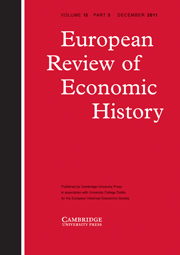Crossref Citations
This article has been cited by the following publications. This list is generated based on data provided by
Crossref.
Lehmann, Sibylle H.
and
O'Rourke, Kevin H.
2011.
The Structure of Protection and Growth in the Late Nineteenth Century.
Review of Economics and Statistics,
Vol. 93,
Issue. 2,
p.
606.
FAITH, ROSAMOND
DAVIS, JAMES
HEALEY, JONATHAN
MURPHY, ANNE L.
BRADLEY, KATE
TAYLOR, JAMES
and
BROWNLOW, GRAHAM
2012.
Review of periodical literature published in 2010.
The Economic History Review,
Vol. 65,
Issue. 1,
p.
322.
WILSON, JOHN K.
and
SHANAHAN, MARTIN P.
2012.
DID GOOD INSTITUTIONS PRODUCE GOOD TARIFFS? EVIDENCE FROM TARIFF PROTECTION IN COLONIAL VICTORIA.
Australian Economic History Review,
Vol. 52,
Issue. 2,
p.
128.
TENA-JUNGUITO, ANTONIO
LAMPE, MARKUS
and
FERNANDES, FELIPE TÂMEGA
2012.
How Much Trade Liberalization Was There in the World Before and After Cobden-Chevalier?.
The Journal of Economic History,
Vol. 72,
Issue. 3,
p.
708.
Lampe, Markus
and
Sharp, Paul
2013.
Tariffs and income: a time series analysis for 24 countries.
Cliometrica,
Vol. 7,
Issue. 3,
p.
207.
Becuwe, Stéphane
and
Blancheton, Bertrand
2014.
La politique tarifaire de la France pendant la première mondialisation.
Histoire & mesure,
Vol. XXIX,
Issue. 2,
p.
155.
Lampe, Markus
and
Sharp, Paul
2014.
Handbook of Cliometrics.
p.
1.
Liu, Dan
and
Meissner, Christopher M.
2015.
Market potential and the rise of US productivity leadership.
Journal of International Economics,
Vol. 96,
Issue. 1,
p.
72.
Caruana Galizia, Paul
2015.
Mediterranean Labor Markets in the First Age of Globalization.
p.
67.
Lampe, Markus
and
Sharp, Paul
2016.
Handbook of Cliometrics.
p.
295.
Kawashima, Toshiki
2018.
A European political-economic space that embraced Japan: the international context of the conventional-tariff network,ca.1892–1914.
European Review of History: Revue européenne d'histoire,
Vol. 25,
Issue. 3-4,
p.
612.
Ciccarelli, Carlo
Dalmazzo, Alberto
and
Vuri, Daniela
2018.
Home Sweet Home: The Effect of Sugar Protectionism on Emigration in Italy, 1876-1913.
SSRN Electronic Journal ,
Varian, Brian D.
2018.
Anglo‐American trade costs during the first era of globalization: the contribution of a bilateral tariff series†.
The Economic History Review,
Vol. 71,
Issue. 1,
p.
190.
Lampe, Markus
and
Sharp, Paul
2019.
Handbook of Cliometrics.
p.
595.
Amaral, Luciano
2019.
The Modern Portuguese Economy in the Twentieth and Twenty-First Centuries.
p.
17.
Lampe, Markus
and
Sharp, Paul
2019.
Handbook of Cliometrics.
p.
1.
Timini, Jacopo
2019.
Staying Dry on Spanish Wine: The Rejection of the 1905 Spanish-Italian Trade Agreement.
SSRN Electronic Journal ,
Eichengreen, Barry
2019.
Trade Policy and the Macroeconomy.
IMF Economic Review,
Vol. 67,
Issue. 1,
p.
4.
Ayuso‐Díaz, Alejandro
and
Tena‐Junguito, Antonio
2020.
Trade in the shadow of power: Japanese industrial exports in the interwar years.
The Economic History Review,
Vol. 73,
Issue. 3,
p.
815.
Timini, Jacopo
2020.
Staying dry on Spanish wine: The rejection of the 1905 Spanish-Italian trade agreement.
European Journal of Political Economy,
Vol. 63,
Issue. ,
p.
101892.


